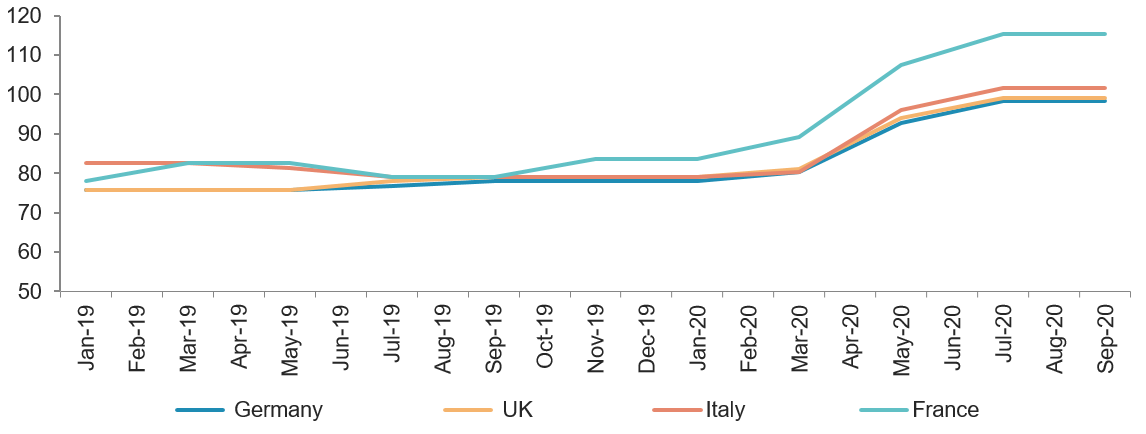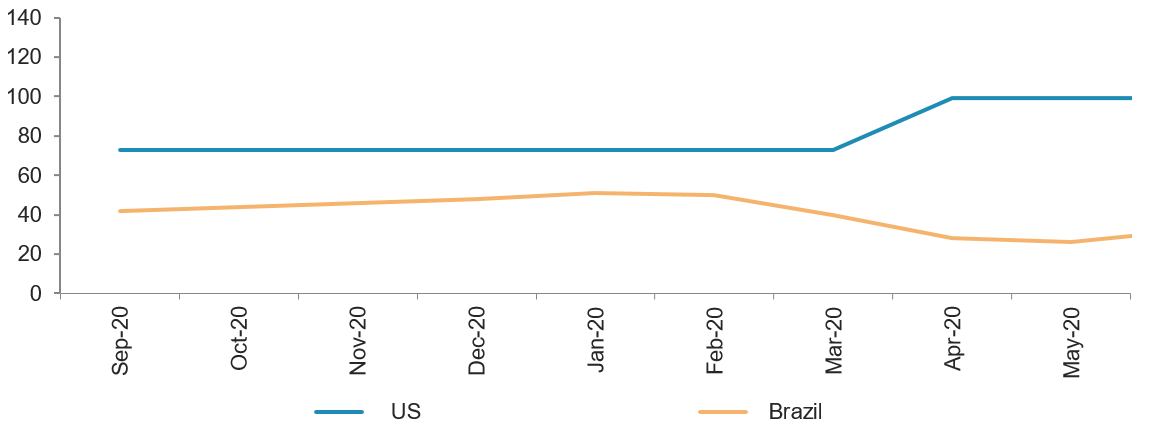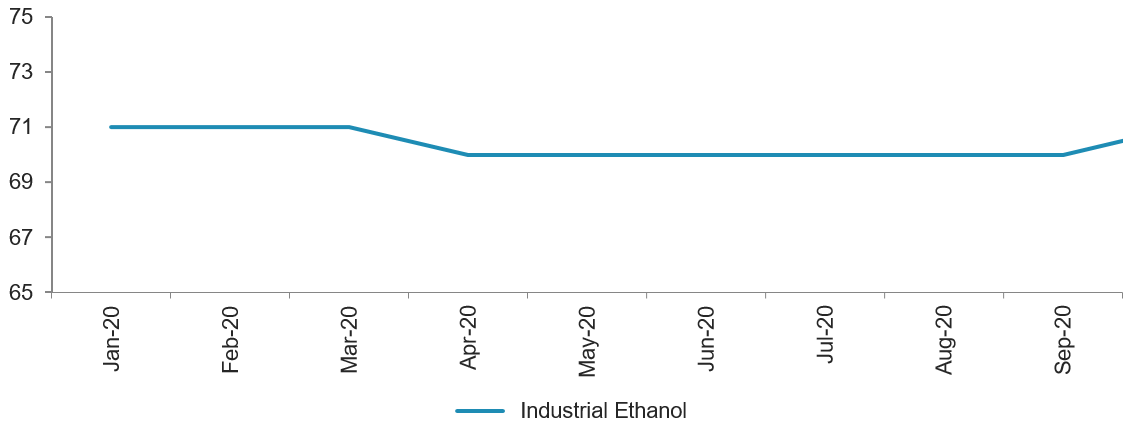Increase in Industrial-Grade Ethanol Prices: The COVID-19 Impact
Published on 03 Nov, 2020

The COVID-19 outbreak led to a surge in the demand for industrial ethanol for sanitizer applications in 1H20. However, the supply chain disruptions caused by the worldwide lockdowns resulted in shortage of ethanol in Europe and the US. This supply and demand gap spiked the prices of ethanol in various regions of the world.
The global demand for industrial-grade ethanol is expected to grow 20–25% over 2019–20. This surge can be attributed to the rising demand for hand sanitizers and disinfectants during the pandemic. Pre-COVID-19, the global demand for industrial ethanol was the highest in the chemicals, and cosmetics & personal care industries, with a strong market share of 55% and 30%, respectively. Other industries such as paints & coatings and pharmaceuticals accounted for the remaining shares. The growth trajectory of the industrial ethanol market has changed drastically since January 2020. Demand for ethanol in large European economies such as Germany, Italy, and France surged around 10x times during 1H20.
Substantial decline in supply across Europe and Asia
Overall, industrial ethanol accounts for 7% of the global ethanol market, while fuel-grade ethanol accounts for the remaining share. Globally, Brazil and the US dominate the overall supply of fuel-grade ethanol and account for 75−80% of the global ethanol supply. The global production of industrial-grade ethanol is estimated to be 11,000 million liters in 2020, with China contributing the maximum share (30−35%), followed by Europe (15−20%), Brazil (8−10%), and South Asia (5−10%).
During 1H20, factors such as low operating rates, production shutdowns, unavailability of raw materials, and logistic delays pushed the demand-supply gap and subsequently impacted prices. Countries such as Italy, which depend on imported feedstock, faced shortages due to logistical constraints. Lack of storage space at ports led to limited stockpiling in the UK and US. Furthermore, not all fuel ethanol plants in the US produce industrial-grade ethanol, which further led to its production shortage.
Demand-supply gap leads to all-time price hikes
The prices of industrial ethanol surged significantly at the end of 1H20 and continued to hover at high levels from July to September 2020.
Europe
Before the outbreak of the pandemic, industrial ethanol was priced at USD70−90 per hundred liters in Europe. Post the outbreak, the prices shot up to more than USD100 per hundred liters due to supply issues caused by surge in demand, insufficient local production capacity, and low operating rates. Shortages in domestic markets were mainly fulfilled through industrial ethanol imports. Nearly 7,000 tons of denatured ethanol was imported from Brazil in April and May. Europe imports denatured ethanol primarily from Brazil, followed by Peru and Pakistan, while fuel ethanol is mainly imported from the US.
Industrial ethanol prices in Europe remained relatively unchanged during 2019; they rose significantly in 1H20 and are expected to remain high during 4Q20 and 1Q21 compared with the pre-COVID scenario. Prices also rose significantly in France, followed by Italy, the UK, and Germany.

Prices in USD/’00 Liter (Ethanol Industrial 99% FD)
The prices in Europe continued to increase until September 2020 but were expected to drop marginally due to a foreseeable increase in ethanol supplies reinforced by the recent European sugar beet harvest, which is a primary feedstock used in EU ethanol production. The arrival of 30−40 million liters of denatured ethanol from the US and Brazil at the start of October and the expected additional 20 million liters of imports by the end of 2020 would hopefully help to control the rise in prices.
Americas
The pre-COVID-19 rate of industrial ethanol was USD73 per hundred liters in the US, which increased to over USD99 per hundred liters during the pandemic. Industrial ethanol sales reached an all-time high with the increase in demand for hand sanitizers and cleaning products. Sales of hand sanitizers increased threefold from a year ago. Brazil witnessed similar market trends in industrial ethanol sales, despite its production of industrial-grade ethanol being less than that of the US. Shortage of supply led to over 35% increase in prices in March and April and a further 20% surge in June and July.

Prices in USD/’00 liter (US: Ethanol Industrial 200 Proof FOB USG; Brazil: Hydrous Ethanol Index (other uses) – São Paulo State)
Industrial ethanol prices in the US are likely to remain stable, as more and more biorefineries have started producing denatured ethanol. Significant investments to enhance operations are set to increase the overall supply in the domestic market and control the incremental price rise.
In Brazil, prices are mainly driven by demand from fuel usage. Therefore, in March and April 2020, the reduced use of vehicles caused prices to decline. The prices in Brazil are expected to plummet against the landscape of robust production capacities.
Asia
Sufficient production of industrial ethanol in Asia allowed the prices to increase only marginally in the region during the pandemic. China was the first country to be termed as a COVID-19 hotspot in South Asia; ethanol prices were not much affected in the region, as production and trading activities were not impacted significantly, and demand changed only marginally. In some parts of South Asia, end-user companies were substituting industrial-grade ethanol with fuel-grade ethanol for hand sanitization.

Prices in USD/’00 liter (Bangkok Ethanol Reference Price)
In South Asia, most downstream producers switched from using isopropanol (IPA) to fuel or industrial-grade ethanol in the production of disinfectants and hand sanitizers to cope with the growing demand. In the coming months, the prices are likely to decline, as producers have equipped themselves with increased capacities and robust inventories.
Conclusion
The increase in supply of industrial ethanol as well as the growing adoption of alternatives to cater to the growing demand for hand sanitizers, cosmetics, and personal care products are expected to stabilize prices in 4Q20 and 2021. IPA as well as n-butanol, isobutanol, n-propanol, and chlorine compounds can be used as substitutes of industrial ethanol in some applications. However, the prices may shoot again in case a second wave of COVID-19 hits the world.
